York Corporation Tramways (City of York Tramways)
History
York Corporation became a tramway owner and operator on the 27th February 1909, when it took over the 4ft-gauge, horse-drawn tramway of the City of York Tramways Company. At that time, the tramway was just 2.57 miles long, consisting of a single line (with passing loops) running from a terminus opposite the Plough Inn in Fulford northwards along Fulford Rd and Fishergate, over Castle Mills Bridge, along Castlegate and Clifford St, before turning westwards over the Ouse, through Micklegate Bar, and along Micklegate and Blossom St to a terminus at the Mount.
Under the terms of the Tramways Act of 1870, the corporation had first been entitled to purchase the tramway, or to be precise the section between Fulford and Castlegate, on the 11th August 1900, the remainder falling due on the 2nd June 1902. As the first of these dates loomed, the tramway company approached the corporation with proposals for converting the tramway to mechanical traction (actually electric, though it wasn't specified at the time) and extending it. This was clearly going to be expensive, so the CYTCo not unnaturally sought some assurance from the corporation as to its tenure, not wishing to risk its capital only for the corporation to force through a compulsory purchase. The council was unwilling to give up its right to purchase the undertaking, and though the company eventually obtained powers (in 1897) to convert and extend the system, the threat of compulsory purchase remained, as well as a council veto over the means of traction adopted.
This effectively put paid to any plans the company had to improve the tramway, so there things lay until 1899, when the corporation approached the company to see how much they would be prepared to sell the undertaking for. The two parties initially failed to agree on a price, but with the first compulsory purchase date fast approaching, and with the very real prospect of losing the Fulford line (including the depot), the company had little choice but to come to terms. An agreement was reached in principle on the 29th January 1901 for the council to take possession in 1903, thus allowing the latter time to develop plans and acquire the necessary powers, the company continuing to operate the tramway in the interim. Unfortunately, and as a result of divisions within the council, the plans for a municipal tramway were put to a poll of ratepayers (in February 1902), where they were decisively rejected, which not only left the CYTCo in possession of the tramway, but one with much improved track, courtesy of the council, who had extensively relaid it in misplaced anticipation of its acquisition.
A majority of the council were however still very much intent on constructing and operating a municipal tramway system, though realistically, they would either now have to wait until the 11th August 1907 to trigger a compulsory purchase (under the '7-year' rule of the 1870 Tramways Act) or pay a price that the company deemed acceptable. In 1905, the corporation once again sounded out the company about how much they would be prepared to sell the tramway for, which the latter responded to by offering to partner with the corporation in conversion/operation, something the latter were once again unreceptive too.
The stand-off (and complete lack of progress on electrification) seems to have encouraged a new player — the York and District Tramways Company — to enter the fray, which it did in August 1906 with proposals to construct a surface-contact electric tramway in the city. The appearance of the Y&DTCo appears to given much-needed new impetus to the corporation's own plans, the result being that they not only blocked the Y&DTCo's proposals, but quickly reached agreement with the CYTCo (in early 1907) to purchase the undertaking in 1909.
The corporation then spent some considerable time discussing which routes should be built and what form of electric traction should be used (i.e., overhead, surface contact, conduit, etc.). Powers were duly acquired — on the 19th October 1908 — to convert the horse tramway to electric traction and to build new lines, the corporation taking over operation of the horse tramway on the 27th February 1909. Quite bizarrely, the council then once again decided to conduct a poll of ratepayers, this time to see whether the corporation should: build and operate the tramway; build and lease it; or have a company build and operate it. Fortunately, this time the populace came down firmly on the side of municipal ownership and operation, a journey that could have been started way back in 1902, but which the ratepayers had rejected.
As the new tramway was to be built to the narrower gauge of 3ft 6ins, the horse tramway was closed completely on the 1st September 1909, construction having begun 6 days earlier on the 1st September. Horse omnibuses were used in the interim, the first electric services commencing on the 20th January 1910, initially between Nessgate and Fulford. The system was completed in June, though strictly speaking the Acomb line was not finished until the 1st August 1911 due to the need to completely rebuild Holgate Bridge, the trams operating a shuttle service on either side during the reconstruction.
Powers to build extensions were obtained in 1912 and again in 1914, which resulted in the opening of a line to South Bank (on the 30th July 1913), a short extension of the Haxby line (on the 19th January 1916), and finally, a line along Hull Rd (on the 14th June 1916). The latter brought the system to its final size of 8.49 route miles, which consisted of six radial lines (3 to the west of the River Ouse and 3 to the east), connected by a central spine running along Station Rd and Blossom St. The individual lines ran: southwards to South Bank; southwestwards to Dringhouses; westwards to Acomb; northwards along Haxby Rd to Rowntree's Cocoa Works; eastwards along Hull Rd to a terminus outside the Bees Wing Hotel; and southeastwards to Fulford Village.
The tramway was one of only a handful of systems that operated trailer cars, though they were only permitted to be used on workers' services, the YCT having difficulties meeting passenger demand, particularly on the Haxby Rd route. Although these were obtained in 1914, they remained idle until the arrival of new, more powerful tramcars (which could pull them fully loaded) in 1916. The fact that the corporation was able to secure delivery of the new tramcars, as well as build the Haxby Rd and Hull Rd extensions in war time, strongly suggests that the two latter routes served vital war industries. Although the system undoubtedly suffered during the Great War from the loss of tramwaymen (and their skills) as well as shortages of parts and material, it was probably impacted less than most systems given that it had only been built and equipped relatively recently (1910).
In 1914, the corporation had secured powers to operate motor and trolleybuses, which it duly exercised, purchasing four battery-electric buses to test the waters, these being introduced on new routes to Heworth and Clifton in February 1915. Two gas buses also appeared — on a new route to Leeman Rd — in 1917, each being converted to use petrol after the war.
The corporation's powers to use trolleybuses were finally made use of in 1920, some 6 years after they had been obtained, services commencing over the Heworth line on the 22nd December 1920, the battery buses having reached the end of their working lives.
Up until 1918, the tramway had been profitable, frequently paying substantial sums to subsidise the municipal rates, but by 1918, with inflation picking up dramatically, a loss was incurred, not helped by the loss-making omnibus services. In fact, the tramways, which were soon put back into profit, continued to subsidise both the trolleybuses and the omnibuses, the former only managing to make a profit in a single year (1928) and the latter, only from 1924 onwards, and even then not every year.
In late 1929, the Tramways Department was formally renamed 'York Corporation Transport Department' to reflect the diverse forms of traction used in delivering a service to the travelling public. At this time, the future of the tramway still seemed relatively secure, two virtually new-build tramcars entering service the same year, with 6 second-hand cars arriving between 1928 and 1930. Powers were even obtained for an extension from Fulford to the football ground, though these were in the event not acted on. By the early 1930s however, things were not well, the city had outgrown the tramway system, and it was now suffering competition from independent bus operators who served the suburbs more effectively; furthermore, key voices within the council were of the opinion that the trams should be scrapped.
In 1932, the corporation was approached by the West Yorkshire Road Car Company, a bus company owned by the London & North Eastern Railway Company, with proposals to replace the trams with buses. Following long negotiations, it was agreed that all the corporation's transport assets would pass to a joint corporation/company undertaking — known as the York West Yorkshire Joint Committee — on the 1st April 1934.
Following its formation, the YWYJC quickly made plans to replace the trams, the first line (Dringhouses) being abandoned on the 6th January 1935, with the rest of the system following 10 months later on the 16th November 1935.
Uniforms
Following its take-over of the City of York Tramways Company on 27th February 1909, York Corporation operated the old horse tramway for some six months before its eventual closure on 7th September 1909. It would seem that the men working these services continued to wear the same style of uniforms that they had worn whilst being in the employ of the company (see link), i.e., single-breasted jackets with five buttons and lapels, along with a matching waistcoat and a kepi-style cap. According to Murray ('The Horse Tramways of York; LRTA 1980), the corporation issued new caps to its seven drivers, seven conductors, and two inspectors; these bore 'Y C T' initials and either 'DRIVER', 'CONDUCTOR' or 'INSPECTOR', more than likely embroidered given the lack of reflections on photographs taken during the corporation's tenure.
Horse tram staff were also issued with long, double-breasted greatcoats with five pairs of buttons and lapels, but devoid of insignia.
Staff working the newly inaugurated electric services were issued with a completely new style of uniform. Conductors wore single-breasted jackets with five buttons, two breast pockets (with button closures) and upright collars; the latter bore an employee number on the bearer's left-hand side, and systems initials — 'C Y T' — on the right-hand side, almost certainly in nickel. Motormen on the other hand wore double-breasted lancer-style tunics with five pairs of buttons (narrowing from top to bottom) and stand-up collars; the latter bore the same insignia as conductors. Caps were in a military style with a tensioned crown (top) and a glossy peak; they bore standard, 'off the shelf' script-lettering grade badges — either Conductor or Motorman — almost certainly in nickel. Both types of tunic had epaulettes: these had button closures and bore a badge of some description, the precise form of which is currently unknown. Although marked 'City of York Tramways' buttons exist (see link), the early studio portrait below shows a motorman who appears to be wearing tunic buttons without a system title, suggesting that the titled buttons may only have appeared later.
The Tramways Department was formally renamed 'York Corporation Transport Department' in late 1929, following which the 'C Y T' system initials on the collar were replaced by one-piece 'YCTD' badges and the 'City of York Tramways' buttons by a pattern bearing the new title: 'York Corporation Transport Dept'. In the early 1930s, a change was also made to a more modern style of jacket, single-breasted with lapels; the latter probably carried an employee number on the left-hand side and system initials on the right-hand side, though these cannot be made out with certainty on surviving photographs. Tramcar staff were also issued with long, double-breasted greatcoats with five pairs of buttons, high fold-over collars and epaulettes; it is currently unclear whether they bore any insignia.
Photographs of inspectors are rare, though a couple from around the years immediately prior to the Great War indicates that they wore fairly standard tramway inspector attire, namely, single-breasted jackets with hidden buttons (or an hook and eye affair), edged with material of a finer quality than the main garment. The upright collars bore embroidered 'C Y T' system initials on the bearer's right-hand side, with the grade — Inspector — on the other side. Caps were military in style, bearing the grade — Inspector — in embroidered script lettering (on a hat band).
In common with many UK tramways, York employed conductresses during the Great War to replace male staff lost to the armed services; unlike the majority of systems however, York also had lady drivers (motorwomen). Conductresses were issued with long, tailored, single-breasted jackets with five buttons, four pockets, lapels and epaulettes; the upper lapels (collars) bore the same insignia as male staff. Motorwomen were issued with 'lancer-style' tunics with epaulettes and high, fold-over collars, again probably tailored for the female form; the collars bore the same insignia as male staff. Headwear took the form of a bonnet (possibly felt), which bore a hat band carrying the standard, script-lettering grade badge. Photos also exist of motorwomen wearing dark-coloured straw bonnets without insignia; it is unclear whether these were official issues or not. The ladies were also issued with long, double-breasted greatcoats with high-fold-over collars and epaulettes; the collars probably bore the same insignia as the jackets worn underneath
Further reading
For a history of both the horse and electric tramways, see 'City of York Tramways' by Joe Murphy; self-published (2002).
Images
Horse tram drivers and conductors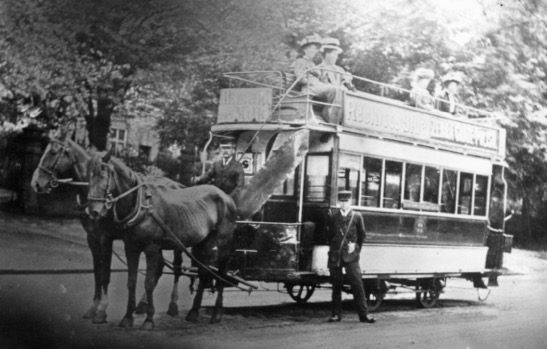
A 1905-acquired horsecar (possibly No 5) stands at the Mount terminus — photo undated, but more than likely taken during the last few weeks of operation given the battered state of the vehicle and the emaciated horses. Photo courtesy of the Tramways and Light Railway Society, with thanks to David Voice.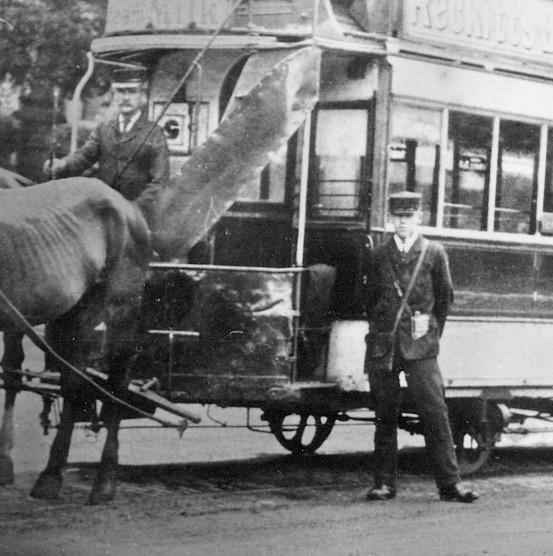
A blow-up of the above photo showing the driver and conductor, both in uniforms (seemingly without insignia) along with kepi-style caps. In corporation days, the caps apparently bore system initials — Y C T — along with the bearer's grade, either CONDUCTOR, DRIVER or INSPECTOR, all more than likely embroidered given the absence of reflections.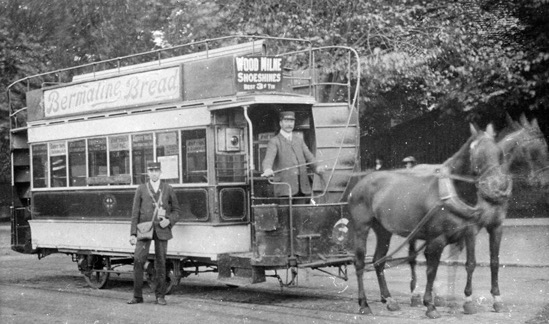
The crew of Horsecar No 6 captured at the Mount — photo undated, but given the battered dash of this 1905-acquired car, probably taken towards the end of operation. Photo courtesy of the Tramways and Light Railway Society, with thanks to David Voice.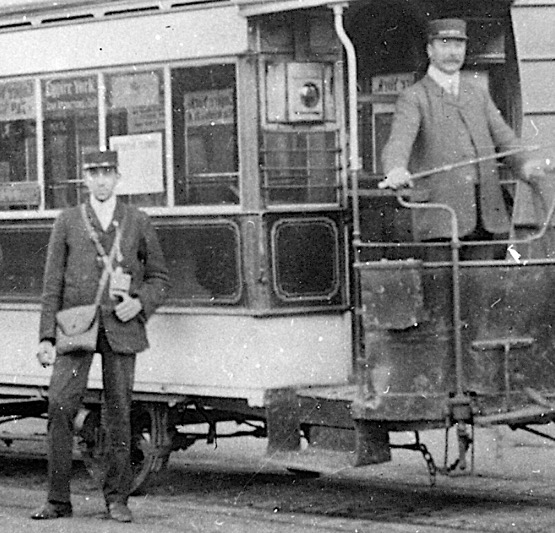
A blow-up of the above photo showing the conductor and driver, both looking reasonably smart in their uniforms.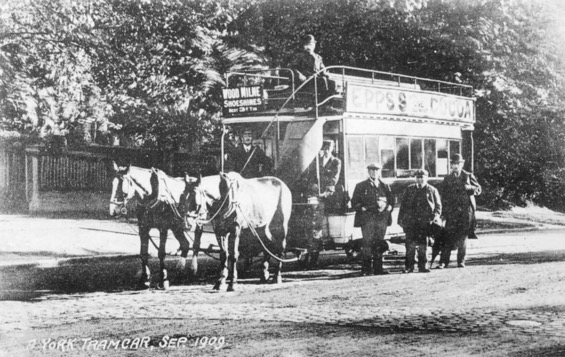
Although a poor-quality photo (taken at the Mount), it does have the advantage of being fairly securely dated to the last week of corporation horse-tram operation (September 1909). Both the driver and conductor are wearing the usual uniforms, along with kepi-style caps. Photo courtesy of the Tramways and Light Railway Society, with thanks to David Voice
Motormen and conductors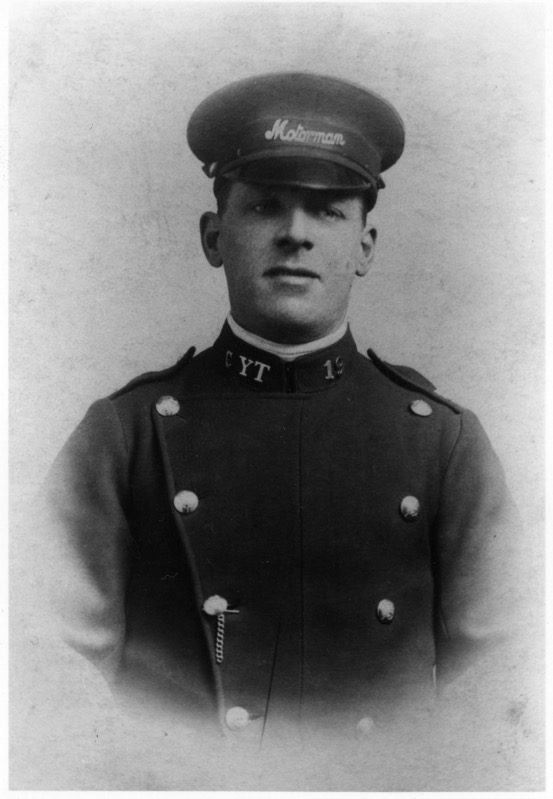
A studio portrait of a York Corporation Tramways motorman — photo undated, but probably taken around the time of opening (1910). His right-hand collar bears 'C Y T' initials, standing for 'City of York Tramways'. Although indistinct, the buttons appear to bear a plain municipal device, suggesting that buttons bearing the system title ('City of York Tramways'), were only introduced later, i.e., after the early uniform issues (see link). With thanks to Nick Thurlow.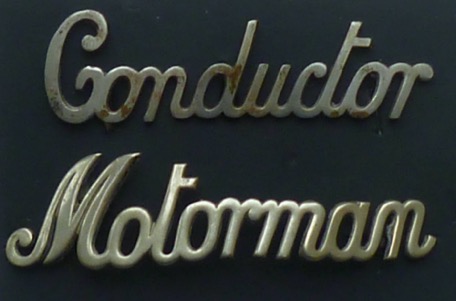
Script-lettering grade badges of the type worn by City of York Tramways staff on their caps — nickel. Author's Collection.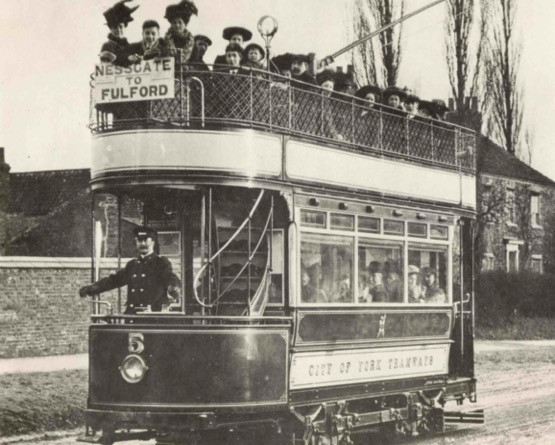
A rather pristine-looking Tramcar No 5 stands at the terminus in Fulford village — photo undated, but almost certainly taken in 1910. Author's Collection.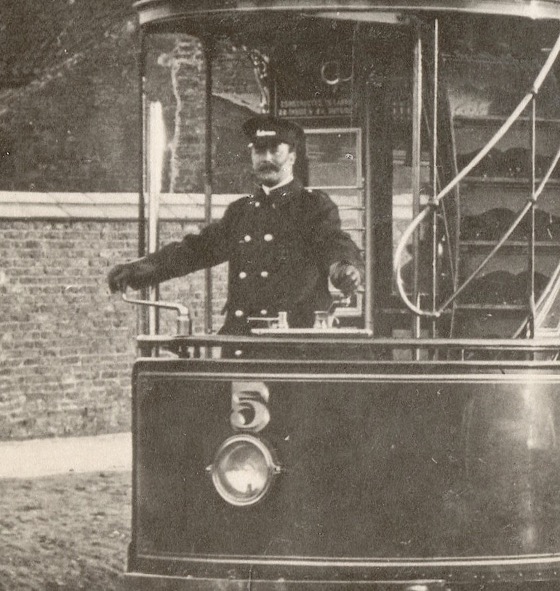
A blow-up of the above photo showing the motorman. He is wearing a double-breasted greatcoat with epaulettes, along with a military-style cap with a script-lettering grade badge.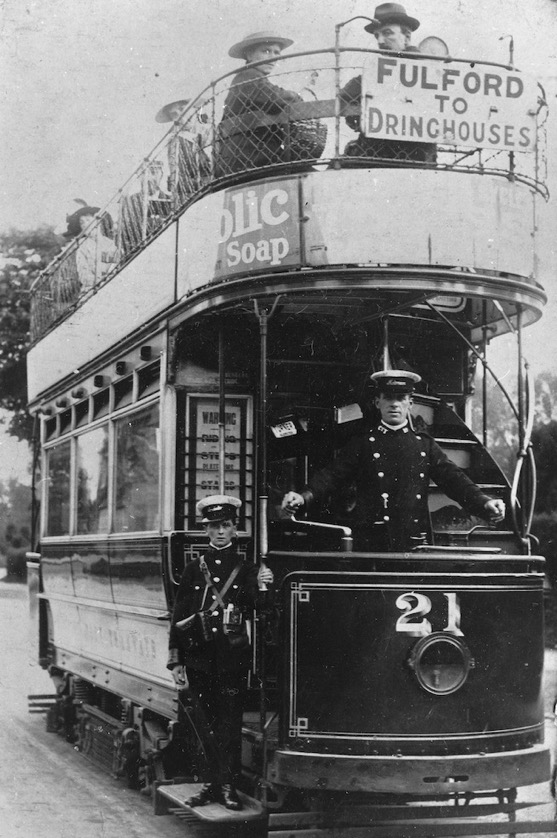
Tramcar No 21 pictured with its crew at what is probably the terminus in Dringhouses — photo undated, but almost certainly taken during the Great War given the age of the conductor. Author's Collection.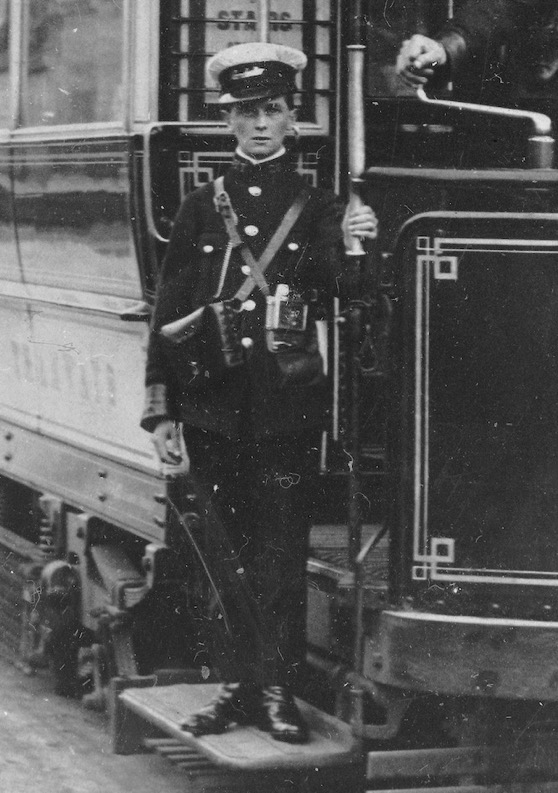
An enlargement of the above photo showing the extremely youthful-looking conductor in his smart, single-breasted uniform.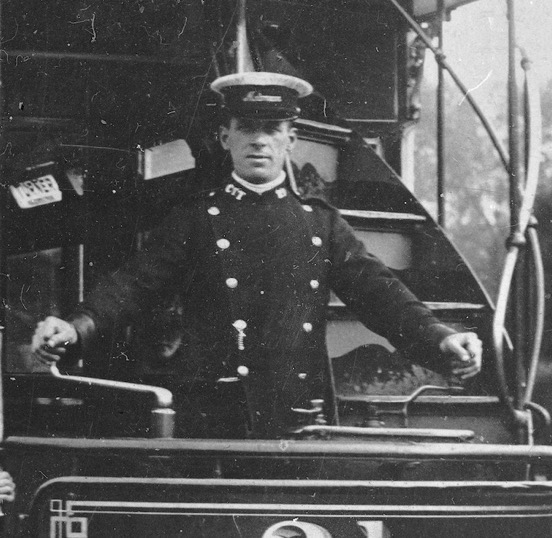
Another enlargement of the above photo showing the motorman, possibly Employee No 29, in 'lancer-style' tunic.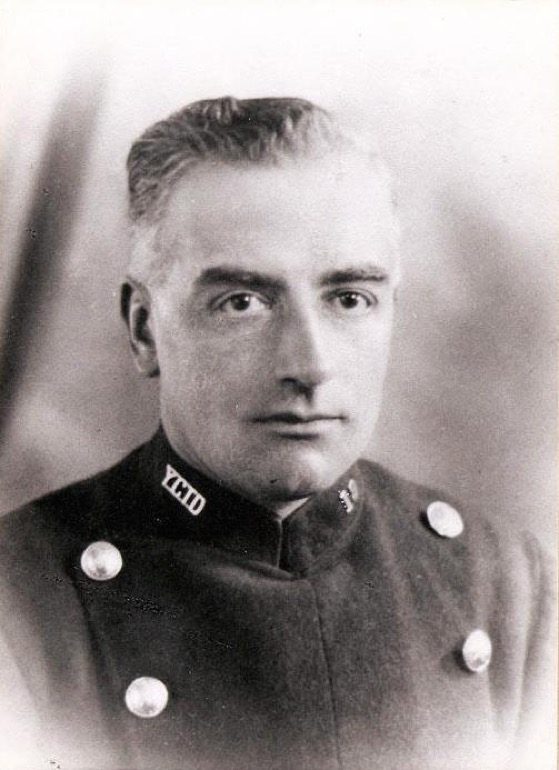
Motorman Fred Legg of York Corporation Tramways — photo probably taken in the late 1920s or early 1930s as the department was formally renamed 'York Corporation Transport Department' in late 1929. The one-piece 'YCTD' collar badge reflects the change. Photo courtesy of the National Tramway Museum. 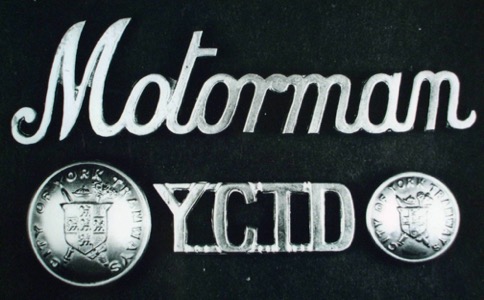
York Corporation Transport Department badge and standard 'Tramway' buttons — nickel. With thanks to Gerald Knox.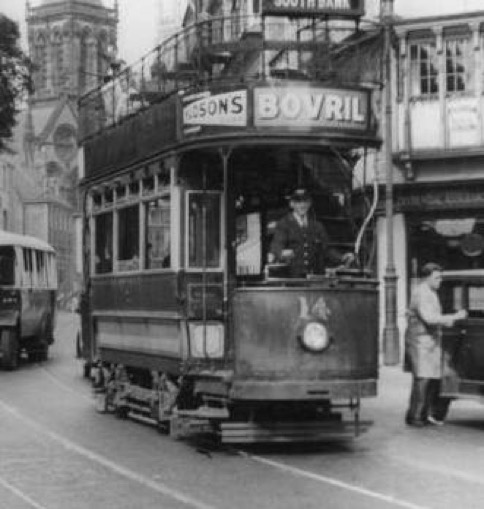
A poor quality photo, but one which does illustrate the later style of single-breasted jackets with lapels. Tramcar No 14 on a service to Southbank — photo undated, but very probably taken in the early to mid 1930s. Photo courtesy of the Tramways and Light Railway Society, with thanks to David Voice.
Senior staff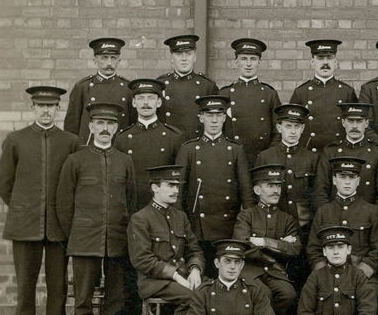
An enlargement of a staff photo taken at Fulford depot on the 4th September 1911, showing two inspectors (on the left). Their caps bear embroidered script-lettering grade badges; their jacket collar insignia is also embroidered, 'C Y T' on the bearer's left-hand side and the grade on the right.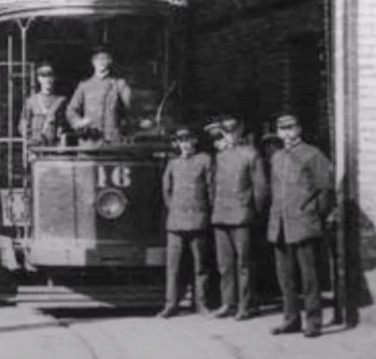
Another poor quality photograph — taken at Fulford depot — but one which shows an inspector (at the extreme right), wearing fairly standard tramway inspector garb; photo undated, but probably taken shortly before the Great War. Photo courtesy of the Tramways and Light Railway Society, with thanks to David Voice.
Female staff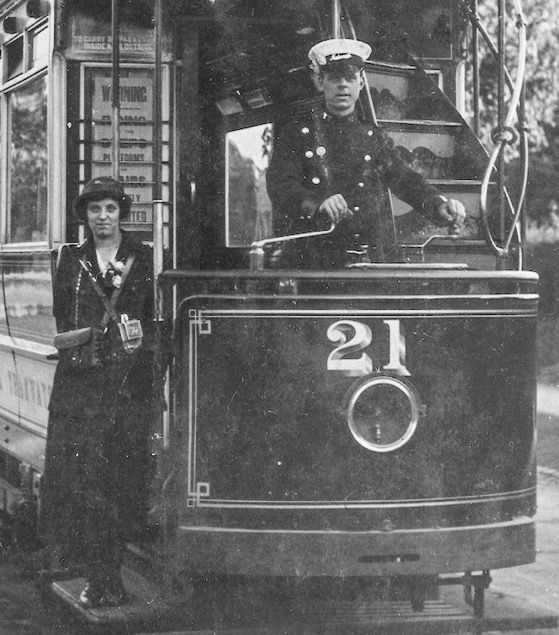
Tramcar No 21 pictured at what is probably the terminus at Dringhouses, with a conductress on the platform step — photo undated, but given that the motorman is wearing a Silver War Badge (issued to honourably discharged servicemen from 1916 onwards), coupled with the absence of a headlamp route number, probably taken around 1916. Author's Collection.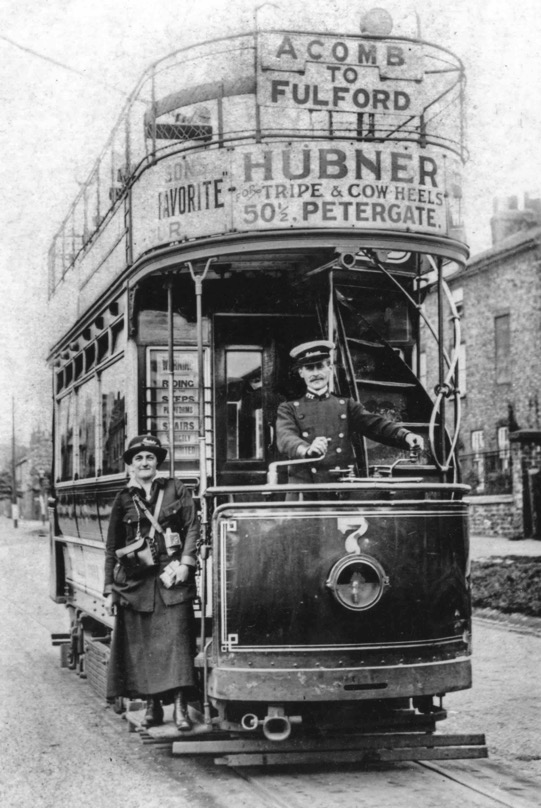
A conductress and motorman with Tramcar No 7 on a service between Acomb and Fulford, probably at Acomb — photo undated, but probably taken around 1916. Author's Collection.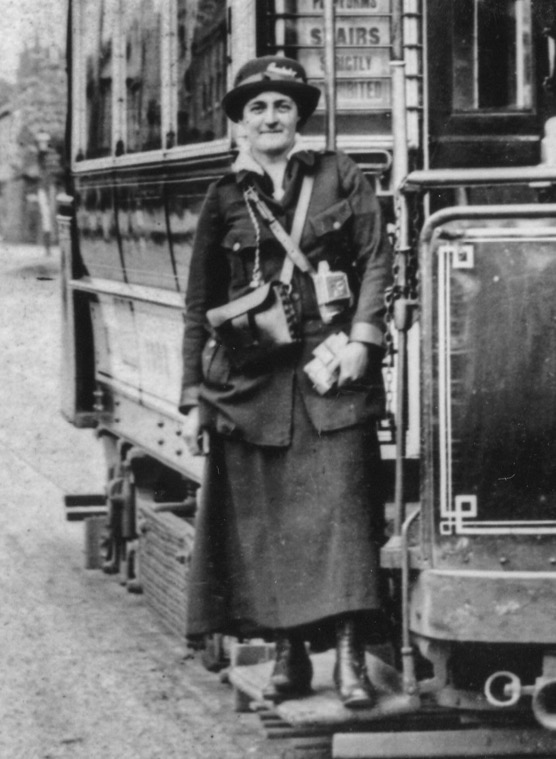
An enlargement of the above photo showing the conductress. She is wearing a tailored single-breasted uniform along with a felt bonnet bearing a script-lettering grade badge.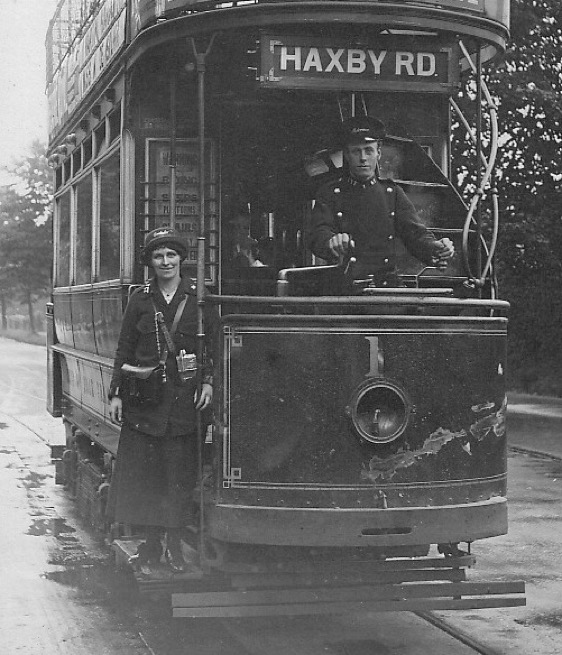
A conductress and her motorman with a rather battered-looking Tramcar No 1 at what is probably the Haxby Rd terminus — photo undated, but probably taken around 1916. Photo courtesy of the Tramways and Light Railway Society, with thanks to David Voice.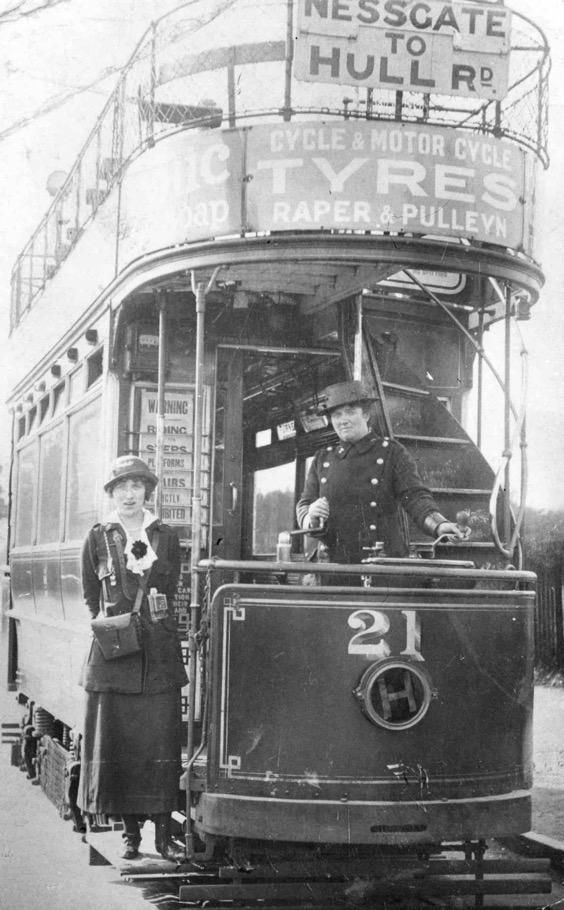
The CYT's first motorwoman (Alice Heppel) poses for the cameraman, along with a conductress and her Tramcar (No 21) probably at the Hull Rd terminus — photo undated, but almost certainly taken later in the Great War given the headlamp route stencil. Author's Collection.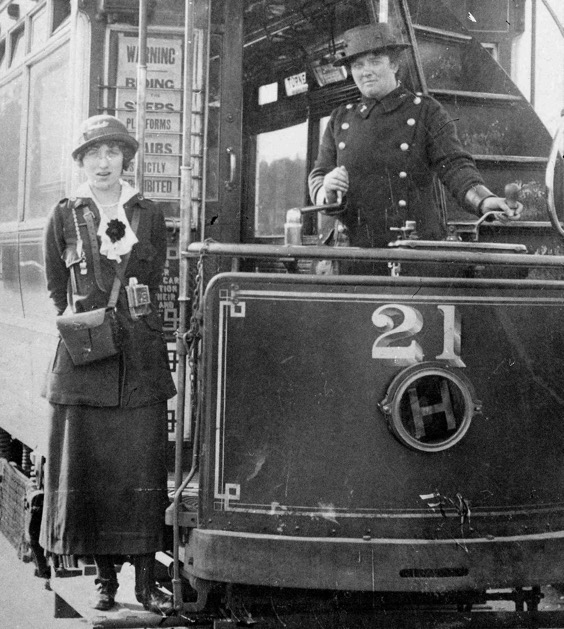
A blow-up of the above photo showing the crew; whilst tailored, the ladies' uniforms match the men's stylistically, i.e., single-breasted for conductresses and double-breasted 'lancer style' for motorwomen. The conductress is wearing a felt bonnet with a script-lettering Conductor badge, whilst Alice Heppel sports an unmarked straw bonnet.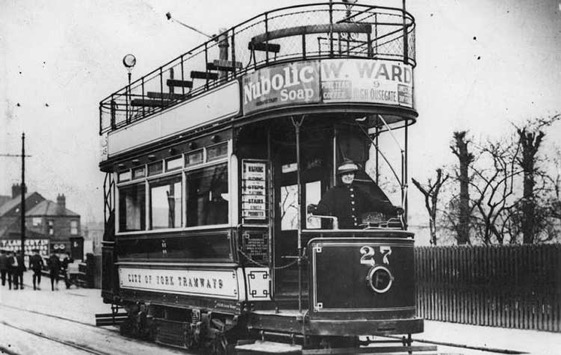
A motorwoman at the controls of Tramcar No 27 at what is probably the Hull Rd terminus. She appears to be wearing an informal bonnet along with a tailored, single-breasted overcoat, possibly self-purchased as all other photos, of which there are many, show ladies wearing double-breasted greatcoats. Photo courtesy of the Tramways and Light Railway Society, with thanks to David Voice.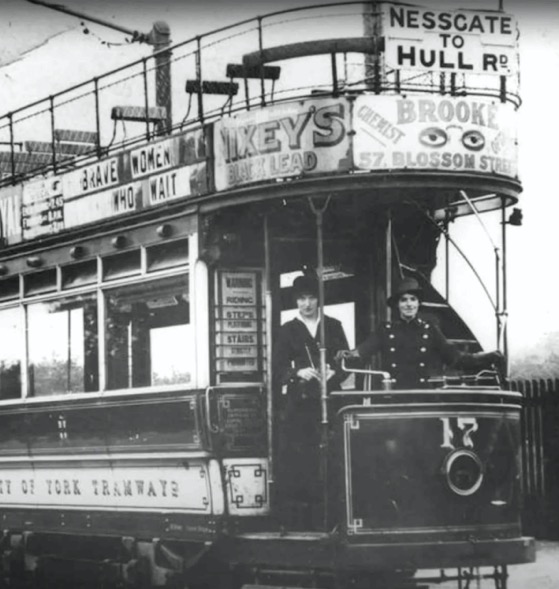
Another all-female crew aboard Tramcar No 17 at what is probably the Hull Rd terminus. Source unknown.